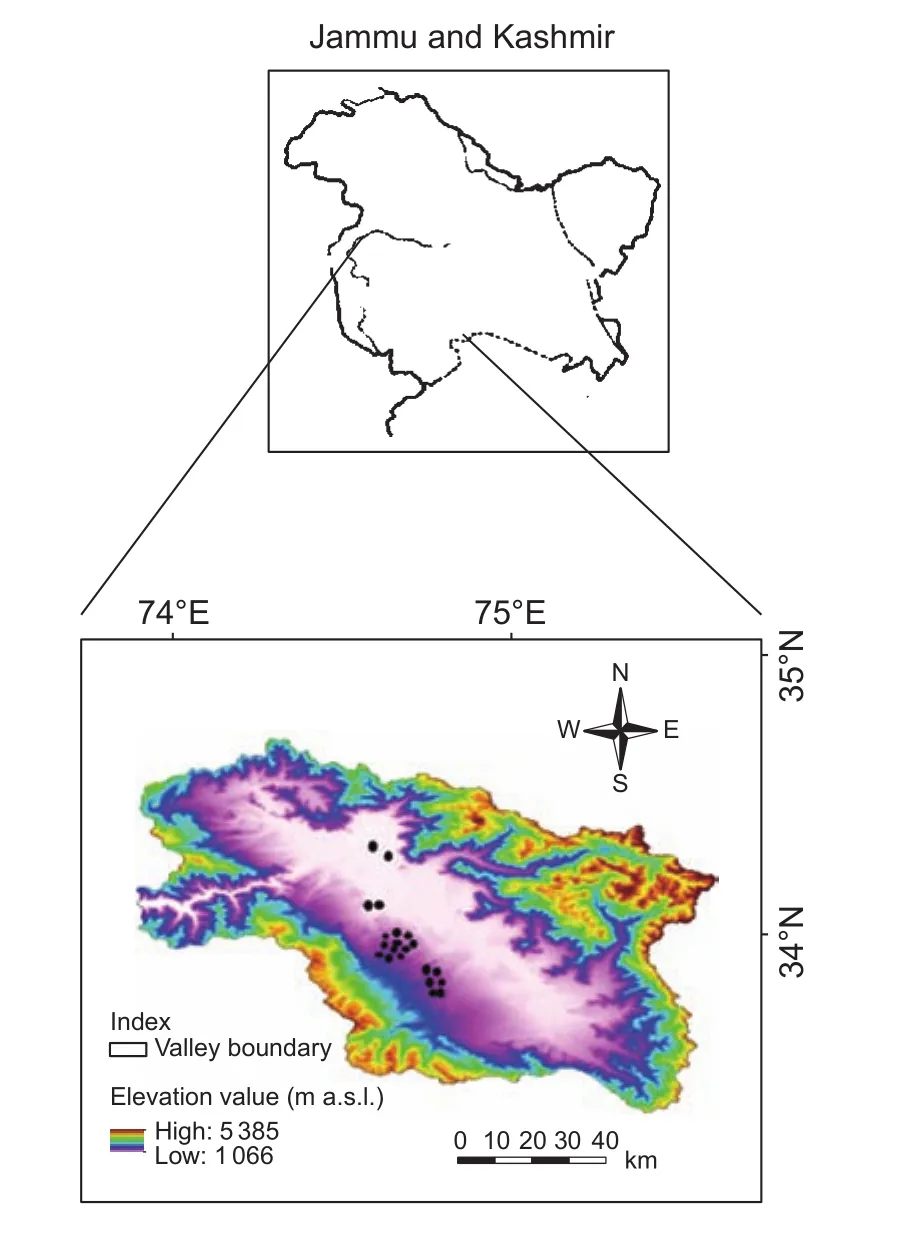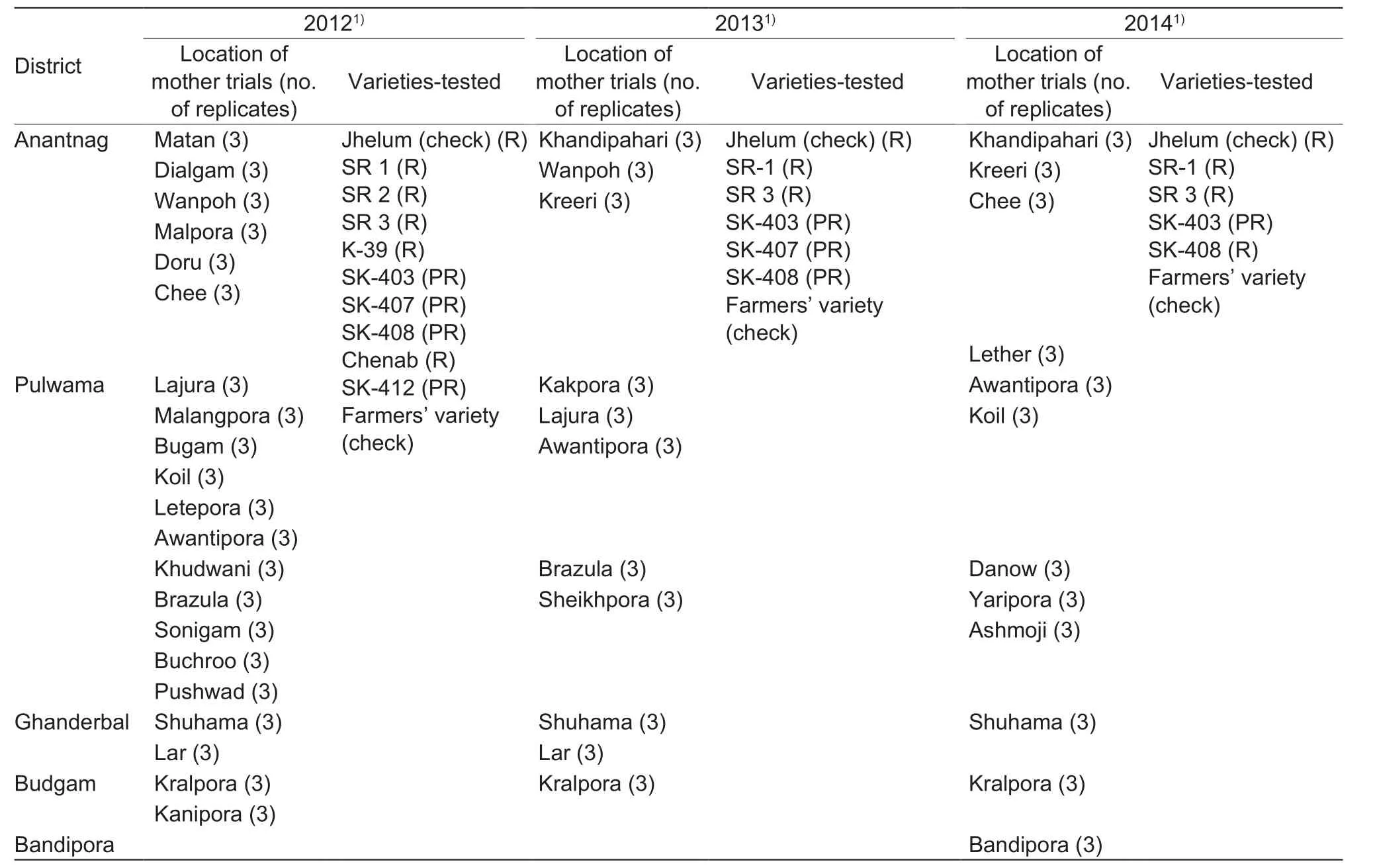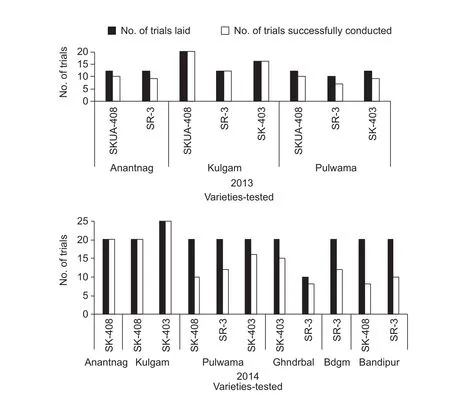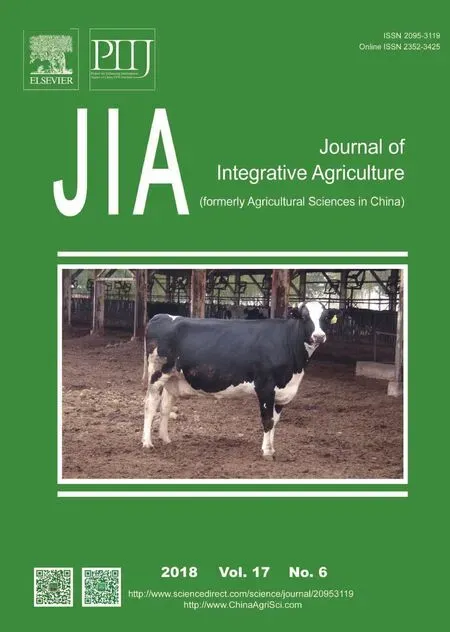Farmers’ participatory selection of new rice varieties to boost production under temperate agro-ecosystems
S Najeeb, F A Sheikh, G A Parray, A B Shikari, G zaffar, S C Kashyp, M A Ganie, A B Shah
1 Mountain Research Centre for Field Crops, Khudwani, Anantnag, Sher-e-Kashmir University of Agricultural Sciences &Technology of Kashmir, Jammu & Kashmir 192102, India
2 Centre for Biotechnology, Sher-e-Kashmir University of Agricultural Sciences & Technology of Kashmir, Shalimar, Jammu &Kashmir 191121, India
3 Dryland Agriculture Research Station, Sher-e-Kashmir University of Agricultural Sciences & Technology of Kashmir, Srinagar,Jammu & Kashmir 191111, India
4 Assistant Director Education, Sher-e-Kashmir University of Agricultural Sciences & Technology of Jammu, Chatta, Jammu &Kashmir 180009, India
1. Introduction
Agriculture is the most primitive occupation in the world and is considered as a heart of the human civilization and settlement. Kashmir Himalaya being the temperate agrobased land is blessed with many natural resources and its climate and environment are very suitable for the successful production of food and cash crops. Aside from being the staple food, rice and its production are important sources of employment and livelihood in rural areas in the Kashmir Valley, India. In contrast to mainland India, the production of rice in Kashmir Valley is dwindling day by day due to use of age-old cultivars. The lack of exposure to new cultivars is one of the main reasons of low cultivar replacement and as a result the old cultivars are still grown on a wider scale.In Kashmir Valley, Jhelum along with some few old cultivars occupy a large proportion of the area under rice cultivation,despite wider choices of rice cultivars released for general cultivation since 1995. The possible reason may be that the newly developed varieties may or may not have satisfied the farmers’ end use because the farmers of hilly and mountainous regions do not have the higher yield as the only priority. They often make the trade-off amongst different traits for final selection of the variety. There is thus a dire need to test a wide range of novel cultivars in farmers’ fields through participatory trials and try to find farmers’ preferences in order to increase the rate of adoption and spread of new varieties.Participatory varietal selection (PVS) is a decisive tool in getting insight about different cultivars based on farmers’perception. This method increases the varietal choice for farmers to make the decision of selection or rejection and the output of plant breeding efforts thus can be more effectively exploited (Joshi and Witcombe 1996).
PVS process has generally four stages: 1) understanding farmers’ needs in a variety; 2) search for appropriate materials; 3) trials to assess its acceptability in farmers’ fields;4) wider dissemination of highly preferred variety/ies by the farmers (Joshi and Witcombe 2002). There are a number of success stories of participatory plant breeding wherein,it has provided an ample choice of varieties to farmers of hilly and mountainous regions (Joshi and Witcombe 2003). Some workers have earlier used this approach while involving farmers as partners during the selection process(Staphitet al.1996; Virket al.2003; Gyawaliet al.2005;Virket al.2005; Rafiqet al.2016). PVS approach has earlier been employed by many workers to evaluate, identify, and disseminate different genotypes on farmers’ field on the basis of farmers’ preferred traits and their perception and aspirations about varietal specification (Joshiet al.2005;Witcombeet al.2005; Gyawaliet al.2010; Yadavendra and Witcombe 2013). Keeping in view, the significance of work in relation to wellbeing of Kashmiri farmers, the present study was carried out based on novel approach of PVS.The farmers were asked to evaluate and to make selections from a set of varieties after making their own judgement.The varietal range was composed of released cultivars and other genotypes developed by Shere-Kashmir University of Agricultural Sciences and Technology of Kashmir which have not been recommended or released so far. In the light of the results, the strategies are discussed in this paper regarding the varietal testing with the farmers that are effectively meeting the needs of poor and marginal farmers.
2. Materials and methods
2.1. Study site
The study sites are located in six districts of Kashmir Valley(33.6–34.5°N; 73.8–75.5°E) at an intermediate altitude range of 1 550–1 700 m a.s.l. (Fig. 1). All the study sites are relatively favourable compared to high altitude zones of Kashmir Valley and the main source of irrigation water is canal system fed by the melting glaciers and the crop is 100% irrigated.
2.2. Field trials
The trials were conducted by the farmers after raising the seedlings at central place of each district in a system of multi-varietal trials (mother trials), however, for single variety trials (baby trials), 4 kg seeds were given to each participant farmer. The vocabulary of the mother and the baby trials follow Snapp (1999).
2.3. The mother trials

Fig. 1 Map showing the distribution of study sites in Kashmir Himalaya, India.
The mother trials were composed of some released varieties and few latest developed pre-released varieties which were used as test genotypes, besides most popular variety, i.e.,Jhelum and farmers’ variety were used as checks. Each mother trial was planted as a single replicate and replication was provided by repeating the trial with different farmers in the same village. The plot size given to each entry in each mother trial was 10 m2. The number of mother trials laid during 2012 was 66; moreover, 36 such trials were also conducted each during 2013 and 2014 (Table 1). Due to the fact of more resources required for supervision, less number of mother trials was conducted compared to number of baby trials in both the years of testing.
2.4. The baby trials
These trials were conducted during Kharif 2013 and continued during Kharif 2014. Each baby trial consisted of one test variety for comparison against the farmers’ variety.One kanal of land (500 m2) was allocated to each baby trial for making comparison with farmers’ own variety laid on the same area of land and were grown as paired plots by each farmer. The area was demarcated by the researchers but trials were laid and managed by the farmers using their own management and fertilizer inputs under the supervision of researchers. The number of baby trials conducted during 2013 and 2014 was 93 and 156, respectively (Fig. 2).
2.5. Statistical analysis
The data for grain yield in kilograms (plot size 10 m2each),days to 50% flowering and plant height (cm) of all mother trials were subjected to ANOVA as an randomized block design (RBD). Pooled analysis was done using Statistical Software “Plant Breeding tools” version 1.4 (IRRI 2014).Pooled least significant differences (LSD) were computed at different probability levels for comparing the mean variation over all mother trials for all three traits (Snedecor and Cochran 1973). Higher yield, taller genotypes, and early flowering were given high ranks (lowest rank means highly preferred). Pairedt-test comparisons were computed for baby trials to test the improved variety in comparison to the farmers’ variety as check (Snedecor and Cochran 1973).
The preferential scoring of the test variety was compared with farmers’ variety and data were recorded as scores,viz.,“highly preferred”, “equally preferred”, and “not preferred”.The data were analysed byχ2analysis using Windows Microsoft Excel, 2007.
3. Results
3.1. Performance of test varieties in mother trials
The present study revealed that the test variety SKUA-408 yielded significantly more than the check varieties,viz.,Jhelum (the most popular variety) and the farmers’ variety. In addition, pre-released variety SKUA-408 consistently yielded more than all other test varieties in all the years of testing;however, no significant yield superiority was recorded over Shalimar Rice 1 (SR1) and SR3 in 2012 and over SR3 during 2014 (Table 2). The observations regarding number of days taken to 50% flowering illustrated that genotypes Jhelum and K39 were the earliest to flower, whereas SKUA-408 was on par with the early flowering genotypes. Analysis of variance showed significant differences of genotypes (test varieties) in relation to study sites (districts) for grain yield,days to 50% flowering (Table 3) and plant height in all the years of testing. This illustrates the fact that the varietal performance was highly influenced by the test locations.During 2012, the most desirable genotype for the tall plant height trait was SR2 followed by SKUA-412 and SR1, while as in 2013 and 2014 it was SR1 followed by SKUA-408 and farmers’ variety, respectively. The plant height of SKUA-408 was significantly higher than that of Jhelum but at par with farmers’ variety. The mean ranking and overall rank order on the basis of three important traits revealed that SKUA-408(rank 1) was better performing in the farmers’ field along with SR3 (rank 2) and followed by Jhelum which ranked the 3rd(Table 3). In the overall ranking of varieties in the mother trials, SKUA-408 was graded in the most preferred groups in all the years. Since the mother trials were conducted strictly under farmers’ management regimes using their affordable levels of inputs over a wide range of land types,so the responses are likely to be representative of entire temperate ecology of Kashmir.

Table 1 Summary of farmer participatory trials conducted during 2012–2014

Fig. 2 Summary of baby trials conducted during year 2013 and 2014.

Table 2 Mean of various traits measured for different numbers of genotypes in mother trials during 2012–20141)

Table 3 Analysis of variance for different agronomic traits in rice
The mean grain yield of SKUA-408 and SR3 (over three years) was significantly superior to farmers’ variety with yield advantage around 27 and 17%, respectively (Table 4).Likewise SKUA-408 showed significant yield superiority around 16% over Jhelum; however, SR3 failed to prove its significant yield advantage over Jhelum. In one more comparison,viz., SKUA-408vs. SR3, the former did not prove any significant yield superiority over the latter. Regarding days to 50% flowering, the test varieties SKUA-408 and SR3 were at par with both the checks (Jhelum and farmers’ variety).
3.2. Performance of test varieties in baby trials
Performance of test varieties in baby trials: The baby trials were carried out under diverse conditions wholly managed by farmers but the area was demarcated by the researchers.For this reason the response are likely to provide a more realistic estimate of the yields without changes in input levels or management practices. All test varieties namely,SKUA-408, SR3, and SKUA-403 demonstrated a significant yield advantages (Table 5) over farmers’ variety (pairedt-test comparison) across different districts during both years of testing (2013 and 2014). In quantitative terms, mean yield superiority of test varieties SKUA-408, SR3, and SKUA-403 over farmers’ variety in 2013 was around 23, 25, and 22%, respectively, whereas the respective yield advantage recorded in 2014 was 16.3, 17.7, and 16.2%.
3.3. Farmers’ assessment about the varieties
In all the districts, SKUA-408 and SR3 were significantly preferred by farmers (P<0.05 or 0.01 usingχ2test) in terms of pre-harvest traits namely, tillering ability and generalphenotypic acceptability, early maturity and biomass and for post-harvest traits such as general cooking quality besides, the intention of growing the variety for next year(Appendix A). The qualitative data analysis demonstrated that farmers’ preference for test varieties in comparison to farmers’ variety was very high (≥62%) with regard to tillering ability and general phenotypic acceptability and cooking quality. Whereas, for early maturity and biomass test varieties did not show any significant advantage in terms of preference. In district Bandipora, the farmers’ variety and the test varieties were equally preferred. The trait superiority of the test genotypes was ascertained by the participating/cooperating farmers in addition to higher yield in comparison to the farmers’ variety. Regarding the 100% intention for growing SKUA-408 in the next season can be imagined by the fact that the neighbours of participating farmers who had not got the seed in the previous year obtained the same at Indian rupee 32 per kg and used the same variety for planting in the next season and showed their highest level of satisfaction with the performance of the variety.

Table 4 Comparison of grain yield (kg 10 m–2) and days to flowering of SKUA-408 and Shalimar rice 3 (SR3) varieties in comparison with controls (Farmers’ variety and Jhelum (popular variety)) in mother and station trials
4. Discussion
4.1. Mother and baby trial approach for adoption and dissemination of new rice varieties
During the present study, a set of varieties were tested in both station and on-farm trials in the target population of environments, wherein, the pre-released variety SKUA-408 and released variety SR3 surpassed consistently with significant margins over the already recommended variety(Jhelum) and farmers’ variety used as checks. The varietal set was selected on the basis of promising performance in the station performance trials and this provided the opportunity of getting more locations/replications across the valley.
Farmers’ observation of improved varieties as perceived through qualitative assessment of various traits in the current study followed the results obtained from quantitative data analysis, despite the fact that qualitative data do not offer a quantitative estimate of yield and other important quantitative traits. Therefore, blend of both costly quantitative data got from fewer mother trials and qualitative data obtained by conducting many baby trials (by trait scoring) can lead to rational conclusion of variety adoption or rejection.Furthermore, it has helped in enhancing the genetic diversity by adding the important and useful allelic resources to already existing rice germplasm base. The mother and baby trials approach has been used by earlier workers to popularize the varieties developed through participatory plant breeding (Joshi and Witcombe 1996; Virket al.2003;Joshiet al.2007; Gyawaliet al.2010; Rafiqet al.2016). In an earlier efforts, promising rice germplasm were evaluated by taking into consideration of farmers’ criteria and selection indices (Witcombe and Virk 2001). The participatory approach has proved to enhance genetic diversity on-farm(Sthapitet al.2001) and in marginal areas it has proved to improve rural livelihoods (Witcombeet al.2001).
In contrast to on-station trials where the researcher follow strictly a system of trade-off among only a few traits (Witcombe and Virk 1997), multiple traits are being evaluated in on-farm testing of the varieties by including farmer as the main stakeholder of the variety (Witcombeet al.2006). Before collecting the data in the present study on the subject of the perception of new varieties from farmers in comparison to farmers’ variety, they were asked about the most desirable traits to be present in a rice variety for early adoption and dissemination. The highly preferred traits desired by farmers were high grain yield, tall plant height,earliness and good cooking quality. Earliness by just one week is the deciding factor for variety adoption because late flowering variety often faces the cold stress at the crucial and most sensitive flowering stage and results in a high degree of chaff and likewise tall plant height is the indicator of straw yield which is the more commercial commodity in Kashmir valley. Similarly a high yielding and blast tolerant variety SR1 which was released and recommended for plain belts of Kashmir valley in 2005 has still not gained any momentum in the farming community for the fact that its maturity duration is late by a week and is not having desirable cooking quality compared to Jhelum.
4.2. Importance and magnitude of farmers’ participatory data
Adoption and dissemination of SKUA-408 began in 2014 from the farm saved seed in the form of farmer to farmer seed exchange. While visiting to fields of participating farmers and other neighbouring farmers in the following crop seasons, it was observed that most of them have expanded the area under SKUA-408 from the farm saved seed. Varieties identified through PVS have faster uptake and dissemination in the farmers’ fields (Tiwariet al.2009). The suitability of SKUA 408 got validated and further confirmed by the sale of around 1.0 ton of seed at unsubsidized rate to a number of farmers of different districts. Seed spread of newly identified varieties through participatory approach from farmer to farmer has earlier been reported (Witcombe and Virk 2001).
The emphasis upon the participatory data to be officially incorporated for varietal testing and release has strongly been recommended by Joshi and Witcombe (2002). Plant breeders should become conscious enough that farmers are the end user of his product and are the judges to decide whether or not to adopt a variety and the traits under looked by the breeders may be the reason of its rejection. So, participatory data should be considered for variety release and a number of farmer preferred varieties could get established in the farming community with no reason of rejection and dejection as is the case with formally released varieties.
5. Conclusion
The results here provide very good evidence that involving farmers in the selection stage of variety development through on-farm testing would prove effective and efficient in identifying farmer preferred varieties to replace the old varieties. Farmers are the end users of a variety, so the decision of the farmers while judging the variety should be given due consideration because widespread adoption of the variety is infact determined by the farmers’ willingness to grow the variety and not by the plant breeder’s decision to promote or reject a variety.
Acknowledgements
This document is an outcome of a project “Participatory Plant Breeding and Strengthening Local Seed System in Kashmir Valley” funded by Rashtriya Krishi Vikas Yojana (RKVY, SKAGR-RKVY-1), India. Due acknowledgement goes to all the cooperating farmers and scientists of Krishi Vigyan Kendras of Sher-e-Kashmir University of Agricultural Sciences &Technology of Kashmir and officers from State Department of Agriculture (Kashmir). Financial support in this endeavour from RKVY is highly appreciated.
Appendixassociated with this paper can be available on http://www.ChinaAgriSci.com/V2/En/appendix.htm
Gyawali S, Bhandari B, Bhandari R, Bajracharya J, Tripathi M,Sthapit B R. 2005. Jethobudho landrace enhancement III:Post-harvest quality traits. In: Sthapit B R, Upadhyay M P,Shrestha P K, Jarvis D I, eds.,On-Farm Conservation of Agricultural Biodiversity in Nepal. Managing Diversity and Promoting Its Benefits.Proceedings of the Second National Workshop, 25–27 August 2004. International Plant Genetic Resources Institute, Nepal Agricultural Research Council,Local Initiative for Biodiversity, Research and Development.vol II, Nagarkot, Nepal.
Gyawali S, Sthapit B R, Bhandari B, Bajaracharya J, Shrestha P K, Jarvis D I. 2010. Participatory crop improvement and formal release of Jethobudho rice landrace in Nepal.Euphytica,176, 59–78.
IRRI (International Rice Research Institute). 2014.PB Tools Version 1.4.Biometrics and Breeding Informatics Plant Breeding, Genetics and Biotechnology Division,International Rice Research Institute, Los Banos Phillipines.
Joshi A, Witcombe J R. 1996. Farmer participatory crop improvement. II. Participatory varietal selection, a case study in India.Experimental Agriculture,32, 461–477.
Joshi K D, Devkota K, Musa A, Johansen C, Gyawali S,Witcombe J R. 2005. An informal network in south Asia:The impact of new rice varieties in Nepal and Bangladesh developed using client oriented breeding.Aspects of Applied Biology,75, 65–66.
Joshi K D, Musa A M, Johansen C, Gyawali S, Harris D,Witcombe J R. 2007. Highly client-oriented breeding, using local preferences and selection, produces widely adapted rice varieties.Field Crops Research,100, 107–116.
Joshi K D, Witcombe J R. 2002. Participatory varietal selection in rice in Nepal in favourable agricultural environments - A comparison of two methods assessed by varietal adoption.Euphytica,17, 445–458.
Joshi K D, Witcombe J R. 2003. The impact of participatory plant breeding (PPB) on landrace diversity: A case study for high-altitude rice in Nepal.Euphytica,134, 117–125.
Rafiq M, Najeeb S, Bhat Z A, Sheikh F A, Iqbal A M, Kashyp S C, Hussain A, Mujtaba A, Parray G A. 2016. Farmer’s participatory varietal selection injaponicarice (Oryza ativaL.) through mother trial evaluation system in Kashmir valley.SABRAO Journal ofBreeding and Genetics,48, 200–209.
Snapp S. 1999. Mother and baby trials: A novel trial design being tried out in Malawi.Target,17, 8.
Snedecor G W, Cochran W G. 1973.Statistical Methods. 6th ed. Iowa State University Press, Iowa.
Sthapit B R, Joshi K D, Rana R B, Upadhaya M P, Eyzaguirre P, Jarvis D. 2001. Enhancing biodiversity and production through participatory plant breeding: Setting breeding goals.In:An Exchange of Experiences from South and South East Asia.Proceedings of the International Symposium on PPB and Participatory Plant Genetic Resource Enhancement,Pokhara, Nepalpp, 1–5 May 2000. Program on Participatory Research and Gender Analysis, International Centre for Tropical Agriculture, Cali. pp. 29–54.
Sthapit B R, Joshi K D, Witcombe J R. 1996. Farmer participatory crop improvement. III. Participatory plant breeding. A case study for high altitude rice in Nepal.Experimental Agriculture,32, 479–496.
Tiwari T P, Virk D S, Sinclair F L. 2009. Rapid gain in yield and adoption of new maize varieties for complex hillside environments through farmer participation - improving option through participatory varietal selection.Field Crops Research,111, 137–143.
Virk D S, Chakraborty M, Ghosh J, Prasad S C, Witcombe J R. 2005. Increasing the client orientation of maize breeding using farmer participation in eastern India.Experimental Agriculture,41, 413–426.
Virk D S, Singh D N, Kumar R, Prasad S C, Gangwar J S,Witcombe J R. 2003. Collaborative and consultative participatory plant breeding of rice for the rainfed uplands of eastern India.Euphytica,132, 95–108.
Witcombe J R, Gyawali S, Sunwar S, Sthapit B R, Joshi K D.2006. Participatory plant breeding is better described as highly client oriented plant breeding. II. Optional farmer collaboration in the segregating generations.Experimental Agriculture,42, 79–90.
Witcombe J R, Joshi K D, Gyawali S, Musa A A, Johansen C,Virk D S, Sthapit B R. 2005. Participatory plant breeding is better described as highly client-oriented plant breeding.I. Four indicators of client orientation in plant breeding.ExperimentalAgriculture,41, 1–21.
Witcombe J R, Joshi K D, Rana R B, Virk D S. 2001. Increasing genetic diversity by participatory varietal selection in highpotential production systems in Nepal and India.Euphytica,122, 575–588.
Wicombe J R, Virk D S. 1997 New directions for public sector variety testing. In: Tripp R, ed.,New Seed and Old Laws.Regulatoryreform and Diversification of National Seed System. Intermediate Technology Publication, London.pp. 59–87.
Witcombe J R, Virk D S. 2001. Number of crosses and population size for participatory and classical plant breeding.Euphytica,122, 451–462.
Yadavendra J P, Witcombe J R. 2013. The impact of maize and rice varieties from client oriented breeding on the livelihoods of poor farmers in western India.Journal of Breedingand Genetics,45, 132–142, 209.
 Journal of Integrative Agriculture2018年6期
Journal of Integrative Agriculture2018年6期
- Journal of Integrative Agriculture的其它文章
- Improve access to the EU market by identifying French consumer preference for fresh fruit from China
- Factors influencing hybrid maize farmers’ risk attitudes and their perceptions in Punjab Province, Pakistan
- Long-term grazing exclusion influences arbuscular mycorrhizal fungi and their association with vegetation in typical steppe of lnner Mongolia, China
- Soil microbial characteristics and yield response to partial substitution of chemical fertilizer with organic amendments in greenhouse vegetable production
- Reducing nitrogen fertilization of intensive kiwifruit orchards decreases nitrate accumulation in soil without compromising crop production
- Ultrastructure of the sensilla on antennae and mouthparts of larval and adult Plutella xylostella (Lepidoptera: Plutellidae)
